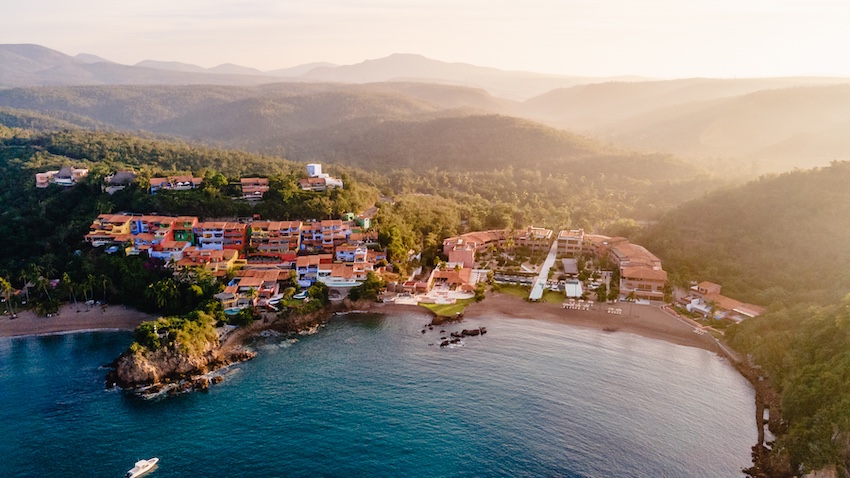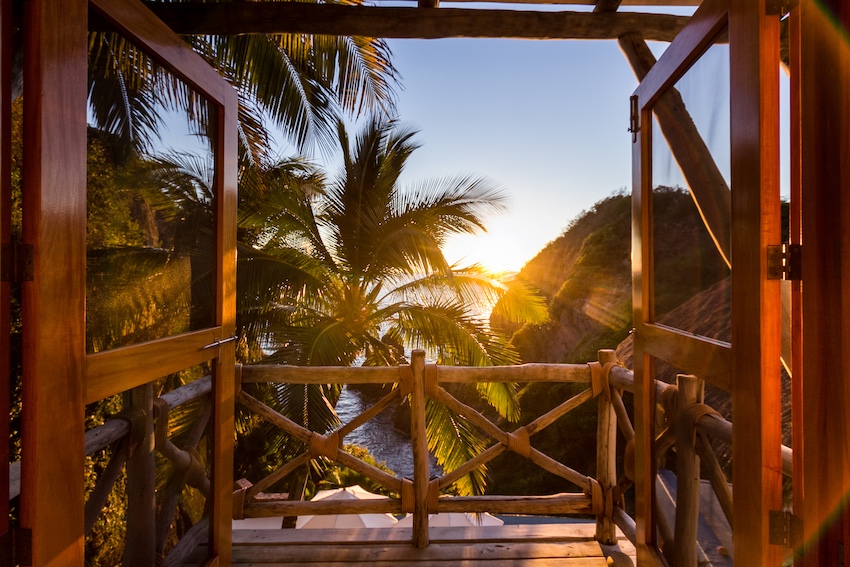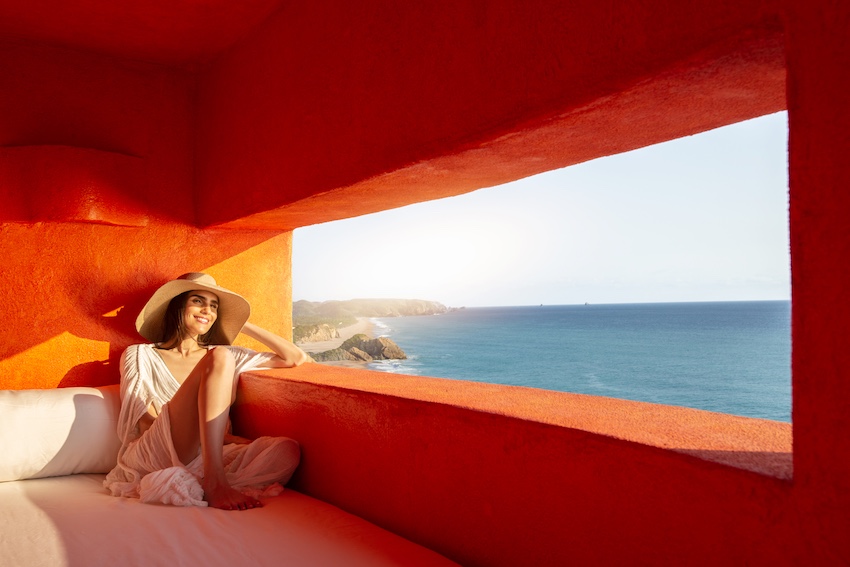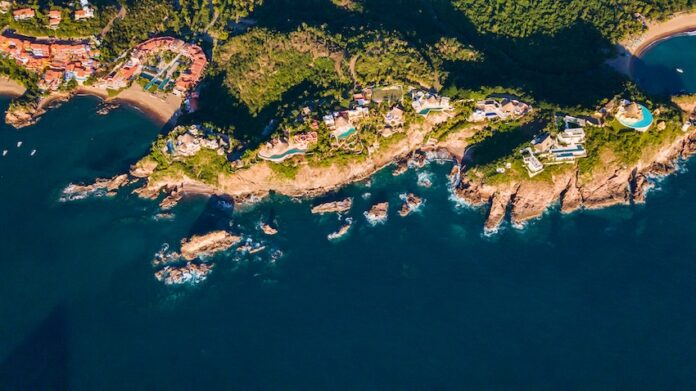When I tell people I once lived in Careyes, their reactions split neatly in two. A dreamy smile from those who know it, or a curious tilt of the head from those who don’t. For the uninitiated, Careyes is a private enclave carved into the wild Pacific coast of Jalisco’s Costalegre, a stretch of shoreline that remains one of Mexico’s least developed, though increasingly on the radar of luxury investors. To live there, however briefly, is to discover a world that is neither resort nor conventional community. Rather, something altogether more elusive, and in many ways, impossible to replicate.
For me, it was also home.
Life in the Pueblo

My days unfolded in the Pueblo, the unapologetically “more affordable” part of the community tucked back from the typical cliffside casitas and palatial villas. Here, the kaleidoscope of pastel casitas is where staff, artists and creatives shared the same bougainvillea-draped streets. The architecture and location of houses in Careyes signal different price points — cliffside castles perched over the sea versus modest bungalows down cobblestone lanes — but social life refused such hierarchies. At night, one could drift from an A-list cocktail reception at a six-bedroom estate to a barefoot music jam in nearby Perula, where neighbors dance to live music and grab a plate of food for 150 pesos.
The fluidity is the essence of Careyes. Wealth is acknowledged but never weaponized. Here, a billionaire and a painter might share the same bottle of tequila while talking about where to find the best surf break on the coast. The connective tissue is not wealth, but a collective agreement that everyone belongs.
That philosophy was embedded from the beginning. When Italian financier Gian Franco Brignone arrived more than half a century ago, he envisioned more than a cluster of vacation homes. He saw a sanctuary where architecture could be playful, where art was integral, and where community (not commerce) was the binding force.
Careyes became famous for its fantastical forms: candy-colored casitas rising from cliffs, castles with wraparound infinity pools, and an eccentric collection of villas designed as much for whimsy as for shelter. Its guests ranged from movie stars to European royals, yet the atmosphere never calcified into exclusivity.
Scruffy elegance
What makes Careyes extraordinary is its paradox. It is undeniably a playground for the wealthy. Homes sell for millions, and private yachts ferry guests in and out. Yet the experience is anything but polished. Roads along the highway are rutted, Wi-Fi is temperamental, and it’s not uncommon to share an outdoor meal with a meandering scorpion or tarantula. Luxury here is filtered through eccentricity and imperfection.
There is a certain “scruffy elegance” to Careyes. Barefoot dinners under the stars, avant-garde art installations rising beside a jungle path, children chasing iguanas while their parents sip a jamaica mezcalita on the sand. It is high net worth without the high gloss — hippies with deep pockets, as more than one resident has quipped. That tension between sophistication and bohemian grit is precisely what gives the place its vitality.
Costalegre’s next chapter

Careyes, of course, does not exist in isolation. It anchors the broader Costalegre, a 150-mile stretch of Pacific coastline extending from Barra de Navidad to Cabo Corrientes. For decades, its remoteness has kept it pristine, until recently, reaching some sections required hours of rough road.
That isolation is beginning to fade, as new developments take root and speculation swirls over a proposed airport — with debate ongoing between government officials and local landowners over whether it will serve private interests or the public at large. The Jalisco government has unveiled a 20-year master plan for Costalegre, pledging to attract sustainable luxury development while preserving the very wilderness that defines it.
“The true luxury of Costalegre is in its nature,” said Michelle Friedman, the Secretary of Tourism of Jalisco. “If we can succeed in blending luxury with environmental consciousness, it will remain one of the last virgin coastlines in the Americas.”
Already, marquee projects are underway. Xala promises a mix of ultra-luxury hospitality with the Six Senses resort and private residences, coupled with large-scale conservation and community investment. El Tezcalame, anchored by Chable Costalegre, will debut in 2027 on land that is mostly reserved for conservation, as well. Even north in Riviera Nayarit, Mandarina has introduced One&Only and Rosewood resorts with branded residences, while Nauka, with its Ritz-Carlton Reserve, is preparing to add another infusion of private community living. Infrastructure upgrades, from highways to new airports, are knitting the region more tightly into Mexico’s tourism fabric.
These projects will undoubtedly shape the Costalegre and Bay of Banderas of the future. But having lived in Careyes, I know they will never quite replicate its essence.
A community apart
Careyes remains singular precisely because it was never conceived as a “development.” It grew out of a vision both eccentric and personal, more interested in community and creativity than marketability. Its residents, whether full-time or seasonal, buy into that ethos as much as into the architecture.

To leave is not just to leave behind a villa or a beach; it is to leave a pace of life orchestrated by nature, by friendships that cross boundaries of wealth and nationality, by nights that begin in candlelit homes and end inside a traditional temazcal under the stars.
The road ahead
As Jalisco’s Costalegre master plan advances, the tension between preservation and progress will sharpen. For some, developments like Xala or Nauka represent opportunity. For others, they raise questions about authenticity and sustainability. But for Careyes, the challenge — and the promise — is different.
It already embodies what the region’s planners say they hope to achieve: a balance of nature and luxury, eccentricity and elegance, community and exclusivity. In that sense, Careyes may be less a relic of the past than a blueprint for the future.
And for those who’ve lived there, even briefly, it remains something rarer still — a place where wealth and whimsy coexist, and where community is the greatest luxury of all.
Meagan Drillinger is a New York native who has spent the past 15 years traveling around and writing about Mexico. While she’s on the road for assignments most of the time, Puerto Vallarta is her home base. Follow her travels on Instagram at @drillinjourneys or through her blog at drillinjourneys.com.
